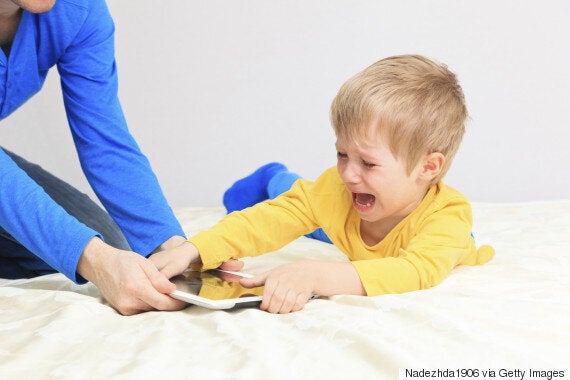As any parent who has experienced tears over the tablet or crying over the console knows limiting the amount of time children spend in front of a screen is easier said than done.
But hitting the off switch doesn't have to involve a wrestle for control, says Gemma Johnson founder of MyFamilyClub.co.uk, who registered National Unplugging Day as an awareness day in the UK.
To mark the event, on Sunday 28 June, Johnson is asking people to set aside some "downtime" away from gadgets and devices, and she has some good advice for how to broach this with your kids without getting into a fight.

"As parents we have to take stock of the impact technology is having on all our lives and support our children who are growing up in a world which is dominated by technology," Johnson said.
"We are right to be concerned about the overuse of tech when we witness the signs of poor concentration and sleep disturbances.
"Not to mention the less noticeable concerns such as eye strain, long term insomnia, depression and series postural issues that affect their future health."
SEE ALSO:
10 Positive Screen Time Activities For Children
Could You Go Without Your Phone, Tablet And Computer For 24 Hours?
Last year a study by MyFamilyClub found that by the age of seven, the average British child born today will have spent an entire year of his or her life in front of a screen.
Psychologist Dr Kimberley Young, who runs the Internet Addiction Clinic, believes parents need to be aware of the effects technology can have on children from birth.
"Sometimes I think advice on internet use should be part of antenatal classes," says Dr Young.
“Children have access to the internet almost from birth now. They see their parents playing on their mobile devices and they want to play too.
"Don’t leave your iPad around because if you do, and children see all the pretty colours they will want to use it too.
"It’s difficult, because having a device can also be very useful in terms of having a reward. But you need to get the balance right.”
Johnson's Guide To Avoiding A Tech-Tantrum
"Straight up removal of children’s and teenagers' tech is not for the fainthearted," cautions Johnson.
"But there is a way to lessen the screams of ‘I hate you’, the tears, the tantrums and slamming of doors. Adopt a five-step strategy to get things back under control and instil healthy digital habits. You probably won’t like this but it starts with you."
Step 1. Set a good example – starting with the parents first.
I can’t reinforce this first point enough. If you are going to be "double screening" i.e. watching TV whilst tweeting about watching TV or sloping off to the loo, smartphone in hand, and your kids see you, then you really don’t have a leg to stand on when setting up boundaries for your children’s tech usage.
As parents we must lead by example, it is harder than it sounds in such a busy and increasingly digital world but children learn from their parents first. So if you want to make a big difference and set ‘healthy digital habits’ in motion then it’s got to come from you first, as hard as that may be.
Nobody likes the smartarse "but you do it too" answer kids throw about, so don’t give them the ammunition to make the tech battle harder than it needs to be!
Step 2. Create a "bucket list "of off-line activities together.
What could be nicer than making a list of fun things to do together, that help you focus your child on off-line activities that facilitate quality time with their parent(s) and making memories.
It's a great way to get your children in a positive mood and looking forward to up and coming events. It’s a win/win as you have a bargaining tool in your back pocket, you get them away from their gadgets and you start creating the expectation of more off-line time, so it becomes a regular feature of your day-to-day lives.
Step 3. Create a media schedule.
Be realistic rather than setting extreme limits and children will be more willing to participate without a fuss.
Children over the age of two years of age should have no more than two hours of screen time per day and that works across all screens including TV.
Create a weekly schedule that can be changed on a regular basis. If the kids go on a cinema trip one day that will eat around an hour or so out of their screen time, so it’s important to have something that is flexible.
Step 4. Introduce a timer for media usage.
A good old fashioned egg timer will do the trick or there are lots apps on the market that will power the gadget down after a particular time limit, which is quite a neat trick as there really isn’t much you can do about it once it’s off.
Step 5. Sleep tight – make their bedroom a no-tech zone.
In order for you to keep an eye on things, you’ll need to have the gadgets somewhere that you can see and control.
A grumpy child can be difficult at the best of times but a grumpy, irritable child through lack of sleep due to tech usage in bed is even worse.
Remember – it’s your house, your rules!
Set your children up with the right attitude to maintain good emotional and physical health whilst navigating the world of tech. It’s never too late to remind them and show them that there really is a big old world out there.